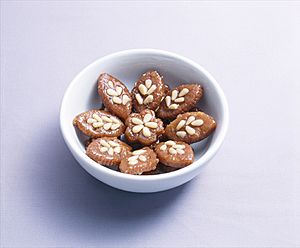Yumil-gwa facts for kids

Yakgwa, a variety of yumil-gwa
|
|
| Place of origin | Korea |
|---|---|
| Associated national cuisine | Korean cuisine |
| Yumil-gwa | |
| Hangul |
유밀과
|
|---|---|
| Hanja |
油蜜菓
|
| Revised Romanization | yumil-gwa |
| McCune–Reischauer | yumil-kwa |
| IPA | [ju.mil.ɡwa] |
Yumil-gwa (유밀과; 油蜜菓) is a type of traditional Korean sweet treat. It's part of a bigger group of Korean sweets called hangwa. To make yumil-gwa, people mix wheat flour with things like honey, cooking oil, cinnamon powder, nuts, ginger juice, jujube (a type of fruit), and a special rice wine called cheongju.
Contents
What Does Yumil-gwa Mean?
The name yumil-gwa tells you a lot about this sweet! It has three parts:
- Yu (유; 油) means "oil."
- Mil (밀; 蜜) means "honey."
- Gwa (과; 菓) means "confection" or "sweet."
So, yumil-gwa basically means "oil-honey sweet"!
A Sweet History of Yumil-gwa
Yumil-gwa has been an important part of Korean culture for a very long time.
- It was often used in jesa, which are special ceremonies to honor ancestors.
- During the Goryeo era (918–1392), these sweets were served at big national parties, religious events, and royal banquets. This included important Buddhist festivals like the Lotus Lantern Festival and the Festival of the Eight Vows.
- Yumil-gwa was even part of royal weddings! For example, it was used in the wedding of King Chungnyeol and a princess from China in 1274. It was also at the wedding of Crown Prince Won in 1296.
Rules About Sweets
Because yumil-gwa was so popular and sometimes used too much, there were rules about it:
- In 1117, King Sukjong said people were using too much yumil-gwa and it needed to be limited.
- In 1192, a rule was made that people should use fruits instead of yumil-gwa for some events.
- In 1353, there was even a complete ban on yumil-gwa for a while!
- Later, during the Joseon era (1392–1897), yumil-gwa could only be used for special ceremonies, weddings, and parties celebrating long life.
How Yumil-gwa is Made
To make yumil-gwa, people first make a dough.
- They mix wheat flour with sesame oil, honey, ginger juice, and cheongju (rice wine).
- Sometimes, they add other tasty things like cinnamon powder, more honey, jujubes, and pine nuts.
- After shaping the dough, the sweets are deep-fried.
- Finally, they are soaked in honey or jocheong (a type of rice syrup) and then dried.
Different Kinds of Yumil-gwa
There are many fun shapes and styles of yumil-gwa:
- Chasu-gwa (차수과) looks like a hand with five fingers.
- Jungbaekki (중배끼) are rectangular sweets that are pan-fried. They are also called junggye (중계).
- Mandu-gwa (만두과; 饅頭菓) are sweet dumplings that are deep-fried.
- Maejap-gwa (매잡과; 梅雜菓) is shaped like a ribbon. It's also known as maejak-gwa (매작과; 梅雀菓) or tarae-gwa (타래과).
- Yakgwa (약과; 藥果) is a very popular type. It's often shaped like a flower and made by molding and deep-frying sweet dough. It's also called gwajul (과줄).
- Yohwa-gwa (요화과) is shaped like a water-pepper flower.

All content from Kiddle encyclopedia articles (including the article images and facts) can be freely used under Attribution-ShareAlike license, unless stated otherwise. Cite this article:
Yumil-gwa Facts for Kids. Kiddle Encyclopedia.
